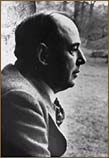C. S. Lewis: The Creator of Narnia - Origins of Narnia
Updated February 21, 2017 | Factmonster Staff 

by Ann-Marie Imbornoni |
| Lewis had first had the idea to write a book for children in 1939. At this time, many children were evacuated from England's major cities and sent to live in the countryside because of the threat of bombing during World War II. Lewis had opened his home, The Kilns, to some of these young refugees, one of whom had been fascinated by a wardrobe there, imagining that there was another way out of it through the other side. This image struck a chord with Lewis, who had first read about a magic wardrobe as a boy, in The Aunt and Anabel by Edith Nesbit. The Lion, the Witch and the Wardrobe Lewis completed his story, The Lion, the Witch and the Wardrobe, in 1948. In it, four children—Peter, Susan, Edmund, and Lucy—go to stay with a reclusive old professor in a mysterious country house. While playing a game, Lucy, the youngest, hides in a wardrobe and discovers that it leads to a magical world called Narnia. This land, which is inhabited by talking animals, is ruled by the lion Aslan, a good and powerful king. Narnia, however, had come under the spell of the evil White Witch, who had caused it to be always winter but never Christmas there. Before Lucy can get back to tell the others about Narnia, her rather bad-tempered brother Edmund discovers it for himself. He is taken up by the White Witch, who lures him to her side with Turkish Delight, a soft, jelly-like candy, and promises of gifts and powers. It is only when Aslan sacrifices his own life that Edmund is saved. Aslan, however, comes back to life. He and his followers win a great battle over the forces of evil, and the four children are made kings and queens of Narnia. At the end of the book, after many years have passed, the children return from Narnia the same way they came into it, through the wardrobe, only to discover that no time has passed at all. Although their adventure appears to be over, the professor tells them that they will again find themselves in Narnia someday, when they least expect it. Lewis went on to write six more Narnia books but not necessarily in the order in which they were to be read. For instance, The Magician's Nephew, which tells of the creation of Narnia and sets the stage for the events that are to happen there, was written next to last and published in 1955. Who Is Aslan? Although Lewis wrote the Chronicles of Narnia with children in mind, he also wanted the stories to appeal to adults and to convey a larger message. Thus the story of Narnia can be read and enjoyed on another level, as the story of Christianity as it is told in the Bible. Aslan the lion represents Jesus Christ, who died as a sacrifice to God for the sins of all people and then came back to life before ascending into heaven. In 1954 Lewis explained it this way in a letter to some Maryland 5th graders: "I said, 'Let us suppose that there were a land like Narnia and that [Jesus], as he became a Man in our world, became a Lion there, and then imagine what would happen.'"  Return to the C.S. Lewis Bio |
See also:
